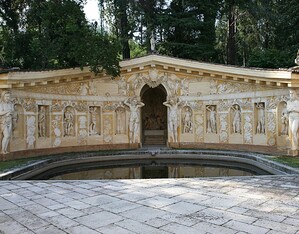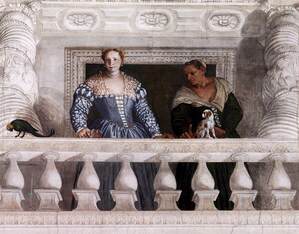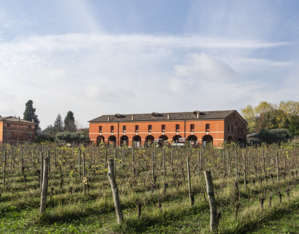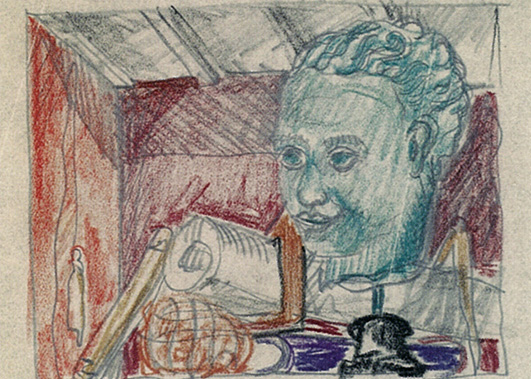 Warning
Warning
Due to the current health emergency situation, visiting times and procedures may be subject to change. It is therefore advisable to check them by contacting the garden directly.
This famous architecture by Palladio, boasts frescoes by Veronese, stucco decorations by Alessandro Vittoria, and a sublimely essential garden with long avenues cutting through the countryside, clipped lawns, and a powerful yet subtle spatial layout.
Built between 1554 and 1559, the design of this villa is included in the Quattro Libri dell’Architettura (Four Books of Architecture) published by Palladio in 1570. The property changed hands several times until the Giacomelli family, in mid-19th century, had it restored, increasing the estate’s wine production, which continues to this day by the current owners, the Volpi di Misurata family, honouring a tradition that was already alive in Palladio’s time since his original design included “places for making wine” located below the current “barchesse” buildings. The landscape context, with the Asolo hills in the background and the slightly sloping terrain, is a key factor in the structure and the organisation of the complex. The garden plan was defined so to provide pleasing views from the main building: on the axis of the protruding facade the long avenue of lime trees stretches out into the landscape of vineyards ending in the semi-circle with the central “Fontana di Nettuno” by Alessandro Vittoria; passing through the entrance gate it continues and divides the internal areas of the enclosed garden, featuring wide stretches of lawn bordered by rows of trees. From a semi-circular opening decorated with statues, a stairway leads up to the upper terrace: on either side the gardens have a formal layout with two symmetrical lawn parterres, with the areas closest to the centre framed with boxwood hedges. At the back of the building is the secret garden, enclosed between the wings of the “barchesse”. Positioned at a higher level it was reorganised by Tomaso Buzzi in the 1930s, with a small fishpond at the centre and the magnificent nymphaeum with grotto. In the 20th century the garden on the other side of the nymphaeum, on the hill in the background, was redesigned by Maria Teresa Parpagliolo Shephard.
Highlights

The nymphaeum
Behind the villa, in the exedra, decorated with garlands, cherubs and trophies, there are ten niches home to statues of divinities, while four telamons support a low tympanum. Two winged figures, either side of the keystone of the arch that gives access to the fake grotto and the spring, hold the Barbaro family crest.

The Tempietto
Commissioned by Marcantonio Barbaro, located on the road that intersects the complex, this small temple is one of Palladio’s last creations: a central-plan building with a front portico, clearly recalling Rome’s Pantheon.

Veronese’s Frescoes
The cruciform salon close to the villa’s vestibule features on its walls decorative motifs that are also characteristic of other rooms, with a false loggia opening out onto an idealised landscape dotted with ancient ruins and allegorical figures inserted into niches. Other important rooms are The Bacchus room, The Hall of Olympus, The Room of Marital Love, The Room of the Dog, and The Room of the Oil Lamp.

The old winery
Under the loggias of the “barchesse” the villa featured the “places for making wine” but from 1850 the Giacomelli family transferred the winery to an adjoining complex, where today excellent wines are produced. The 30 hectares of vineyards located in the DOC area of Montello and the Colli Asolani, are cultivated according to eco-friendly principles.
Find out more
20th-century signature gardens
Architect, landscaper, scenographer, interior designer, designer, Tomaso Buzzi is one of the most interesting personalities on the 20th-century artistic scene.

 Villa Barbaro
Contacts
Villa Barbaro
Contacts
 Villa Barbaro
Opening times and prices
Villa Barbaro
Opening times and prices
Opening hours
From April to October 2021
- Open Saturdays, Sundays and holidays from 10 a.m. to 6 p.m. (last admission at 5.30 p.m.).
- Special openings by appointment, [email protected]
- Monday closed.
- Closed April 3-4-5, as per ministerial regulations.
Schedules may be subject to change in accordance with ministerial regulations. For further information consult the website of the Villa.
Pricing
The garden, during opening hours, is freely accessible to all.
Tickets to visit the Villa:
- Adult € 9,00
- Over 65 € 7,00
- Groups (min 20 people) € 7,00
- Students (from 15 to 23 years old) € 7,00
- Children (from 6 to 14 years old) € 4,50
- Families (2 adults and up to 4 children) € 21,00Groups by appointment only.
The group discount does not apply on Saturday afternoons, Sundays and holidays all day.
 Villa Barbaro
How to get there
Villa Barbaro
How to get there
Address
Via Cornuda, 7
31010, Maser (TV)
Latitude: 45.8121349
Longitude: 11.9743833
How to arrive by road
From Venice take the motorway to Treviso Sud. Pass the motorway tollgate towards Treviso and take the ring road. Then follow the signs for Feltre and take SR 348 Feltre. Staying on the SR 348, 6 km after the exit for Montebelluna you will find a large roundabout, turn left towards Castelfranco/Padova and immediately after turn right towards Cornuda. At the traffic lights in Cornuda turn left towards Maser.
N.B. Some navigators set the actual address to Via Cornuda 7, leading to a country road near the Villa.
How to arrive by train
The best served and nearest railway station is Montebelluna. Alternatively Treviso, Bassano del Grappa or Castelfranco Veneto. From the bus station of Treviso, Montebelluna or Bassano del Grappa there are buses that go to Maser. Please note that where “Bivio Maser” is indicated, the bus stop is about 1.5 km from the Villa.
All hours
How to arrive by bus
Flixbus stops at Castelfranco Veneto From Castelfranco you can continue by bus with La Marca bus lines (Maser stop) or by train to Montebelluna or Cornuda and then by bus.
 Villa Barbaro
Services/Accessibility
Villa Barbaro
Services/Accessibility
Services
The Villa Barbaro shop offers all the products of the winery and the farm, a selection of refined local products, publications on Villa Barbaro di Maser and its frescoes, postcards and souvenirs. It is open during visiting hours. For further information contact the following number: +39 0423 923023.
There is an unattended car park so the Villa recommends not to leave personal belongings unattended.
Tastings (in the historic cellar)
In the old farmhouse adjacent to the Villa there is a refreshment point that offers guided tastings of all the wines of the farm. Dè Gusto is also available for takeaway by contacting +39 3473501473 or +39 0423565603
More info on tasting menusBathrooms are located in the parking lot and farmhouse with bar and shop.
Accessibility
To protect the floors and ceilings there are overshoes available at the entrance to be worn. The Villa di Maser is an ancient building accessed by a staircase of 17 steps with handrail. There is no elevator. The rooms on the main floor are therefore not easily accessible to the disabled. Please contact the Villa for information and advice. Parking is reserved for the disabled inside the gates of the Villa.
 Villa Barbaro
Private events
Villa Barbaro
Private events
 Villa Barbaro
Itineraries
Villa Barbaro
Itineraries
You could find the garden in these itineraries
 Favorite saving result
Favorite saving result
 Warning!
Warning!
You've have to sign up or sign in to add this element to your favorites.
